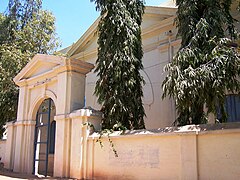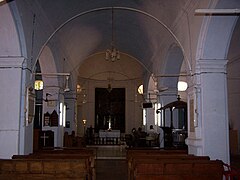Christian Friedrich Schwartz
Christian Fried (e) rich Schwar (t) z , in the English-speaking area Christian Frederic (kh) S (ch) war (t) z, (* October 8, 1726 in Sonnenburg near Küstrin , Mark Brandenburg , Prussia ; † February 13 1798 in Thanjavur , Tamil Nadu ) was a German Protestant - Lutheran missionary in India. He was known for his linguistic skills, with proficiency in Latin, Greek, Hebrew, Sanskrit, Tamil , Urdu, Persian, Marathi and Telugu, and was even used by the British to serve as an ambassador for peace, taking him to the court of Haider Ali was posted to Mysore. He worked with the Indian royal families, overseeing the Raja Serfoji of Tanjore, and was influential in establishing evangelical Christianity in southern India.
Life
Christian Friedrich Schwartz's father was Georg Schwartz and his mother Margaret Gruner. The date of birth is given differently, depending on the source as October 8, 22 or 26, 1726. Schwartz's mother died when he was still young and attended the high school in Sonnenburg under Mr. Helm. He learned Latin and Greek and a certain degree of Hebrew, which he hoped to improve through studies in Küstrin.
In 1746 he moved to Halle to study, where he met Schultz, who had worked in the Madras Mission. Schultz was working on a Tamil Bible , for which he sought help from Schwartz. After learning Tamil to assist with translation, he developed a desire to become a missionary in India. He joined the Danish-Hallesche Mission to do this . He was ordained in Copenhagen on August 8, 1749 . He then spent some time in England to English to learn. Early in 1750 he left for India with the missionaries Georg Heinrich Conrad Hüttemann and David Poltzenhagen .
On July 30th he reached Tiruchirappalli via Tranquebar . Tranquebar was his headquarters for some time, but he often visited Thanjavur and Tiruchirappalli. In 1766 he then moved to Tiruchirappalli. Here he worked as the chaplain of the garrison, which built a church for its general use.
There was an explosion in the ammunition depot of the East India Company in 1761. Numerous local soldiers were killed.
For the orphans of these soldiers, Schwartz set up the Bishop Heber School in Trichinopoly. There was another explosion at an ammunition dump in Trichinopoly in 1763, in which all British soldiers and their wives there died. Only 14 children of the soldiers survived.
For the orphans, Schwartz set up a school in the sacristy of St. John's Church, which was built by the soldiers.
Later the army made some land available, about 20,000 square meters, adjoining the army site to build a proper school. The school was built by Freemasons who were part of the British Army and civilians who were all Freemasons as well.
In 1769 Schwartz secured the friendship of King Raja Thuljaji , who, although he never converted to Christianity , gave him all support for his missionary work. Shortly before his death, he entrusted Schwartz with the upbringing of his adopted son and successor Sarabhoji (Serfoji). Schwartz taught Prince Serfoji (later known as Serfoji II ) and another, slightly older student, Vedanayagam, now known as Vedanayagam Sastriar, using the Gurukulam approach, in which teacher and student live together. Raja Serfoji built a church to express his affection for Schwartz. This is still today a symbol of the tolerance of the important Mahratta ruler towards different religions.
In 1779, at the request of the British administration in Madras (now Chennai ) , Schwartz undertook a private diplomatic mission to Haidar Ali , the ruler of Mysore . As Haidar in the Carnatic occurred (see Second Anglo-Mysore War ), it was Schwartz allowed to cross the enemy camp without harassment.
In 1784 he set up an English school in Thanjavur. This school is now known as St. Peter's Higher Secondary School . After twelve years in Tiruchirappalli, he moved to Thanjavur, where he spent the rest of his life.
Christian Friedrich Schwartz died on February 13, 1798, shortly before Serfoji II ascended the throne. He was laid to rest in the Petrine Church in Maharnonbuchavadi, Thanjavur. At his grave is a memorial stone with a short memorandum and a lament in English, written by Serfoji II.
legacy

Schwartz's immediate success in proselytizing people to Christianity exceeded that of any other evangelical missionary in India. In addition, he won the respect of both Muslims and Hindus . The Raja of Tanjore (Thanjavur) had a monument erected for him in the mission church through John Flaxman . It shows the Raja taking the hand of the dying missionary and receiving his blessing.
The following is a translation of the inscription on the monument donated by Raja Serfoji II:
- In memory of Pastor Christian Friedrich Schwartz. Born in Sonnenburg in the Neumark in the Kingdom of Prussia on October 26th, 1726, died in Tanjore on February 13th, 1798 at the age of 72.
- Devoted to the missionary service in the East from his early manhood, the comparability of his situation with that of the first preachers of the Gospel made him particularly similar to the simple holiness of the apostolic character.
- His natural vivacity won him affection, just as his immaculate honesty and the purity of his life earned him the reverence of Christians, Mohammedans, and Hindus alike. Independent princes, Hindus and Mohammedans, chose this humble pastor to mediate political negotiations with the British government.
- Maha Raja Serfojee
A memorial to John Bacon the Younger dedicated to Schwartz was erected by the East India Company in St. Mary's Church in Chennai. Black High School in Ramanathapuram has had numerous later famous students, including Dr. APJ Abdul Kalam , one of the Presidents of India.
The following images show views and details of the CSI Schwartz Memorial Church in Tanjore, a church that Schwartz had built in 1779:
Remembrance day
February 13 in the Evangelical Name Calendar .
Before the introduction of the official name calendar, the day of remembrance was already listed in:
- Theodor Fliedner : Book of Martyrs , Kaiserswerth 1849/1859, Vol. 4, pp. 1399-1404
- Ferdinand Piper : Evangelical Calendar in Witnesses of Truth , Berlin 1874/1875, Vol. 1, pp. 14-25
- Prussian Evangelical Oberkirchenrat: Calendar of names for the German people , Berlin 1876
- Chr.Geyer: The living calendar , Rudolstadt 1927
- Jörg Erb : The Cloud of the Witnesses , Kassel 1951/1963, Vol. 4, pp. 508-520
- A. Ringwald: People before God , Stuttgart 1957/1968
swell
- Werner Raupp (ed.): Mission in source texts. History of the German Evangelical Mission from the Reformation to the World Mission Conference Edinburgh 1910, Erlangen / Bad Liebenzell 1990, pp. 138–163, esp. 160–163 (Einf., Quellen, Lit. zur Dänisch-Halle Mission and Chr. Fr . Schwartz).
literature
- Hugh Pearson (author), Christian Gottlieb Blumhardt (translator), W. Hoffmann (editor): Christian Friedrich Schwartz, the German missionary in South India , Felix Schneider, Basel 1846
- Rudolf Schwarze : Schwartz, Friedrich . In: Allgemeine Deutsche Biographie (ADB). Volume 33, Duncker & Humblot, Leipzig 1891, pp. 205-208.
- Viktor Hantzsch : Schwartz, Christian Friedrich . In: Allgemeine Deutsche Biographie (ADB). Volume 54, Duncker & Humblot, Leipzig 1908, pp. 273-277.
-
Christian Friedrich Schwartz , in: Encyclopaedia Britannica , 1911, whose sources:
- Remains by Schwartz, depicting life
- Memoirs of Life and Correspondence , by HN Pearson (1834, 3rd edition 1839)
- Life of Christian Friedrich Schwarz , by HN Pearson (1855)
- Werner Raupp : Schwartz, Christian Friedrich. In: Biographisch-Bibliographisches Kirchenlexikon (BBKL). Volume 9, Bautz, Herzberg 1995, ISBN 3-88309-058-1 , Sp. 1153-155.
- Frieder Schulz and Gerhard Schwinge (editors): Synaxis: Contributions to liturgy , Vandenhoeck and Ruprecht, Göttingen 1997, ISBN 3-525-60398-3
Web links
- Christian Friedrich Schwartz, Apostle of South India
- About Abdul Kalam ( Memento from November 13, 2013 in the Internet Archive )
Individual evidence
- ↑ a b Frykenberg, RE: The Legacy of Christian Friedrich Schwartz . In: International Bulletin of Missionary Research . 1999, pp. 130-135.
- ^ Pearson, HN: The life of Christian F. Swartz: Missionary at Travancore. AD 1750-1798 . Seeley, Jackon, Halliday and B. Seeley, London, 1855.
- ↑ C. Venkatesan: Remembering Schwartz in St. Mary's in the Fort , 2008, on MadrasMusings.com
-
↑ a b குடவாயில் பாலசுப்ரமணியன் (2009). தஞ்சாவூர் (கி.பி. 600 - 1850). அன்னம் வெளியீடு, தஞ்சாவூர், பக்கங்கள் 384 + 16. பக்கம் 178.
- (English translation: Kudavayil Subramaniyan: Thanjavur (AD 600-1850) , Annam Publication, Thanjavur 2009, Pp384 + 16, p. 178.)
- ↑ Indira Viswanathan Peterson, David B. Truman: The Memorials of Schwartz on MadrasMusings.com
| personal data | |
|---|---|
| SURNAME | Schwartz, Christian Friedrich |
| ALTERNATIVE NAMES | Schwartz, Christian Friederich; Schwartz, Christian Frederic; Schwartz, Friedrich; Schwartz, Christian Frederick; Schwarz, Christian Friedrich; Swartz, Christian Frederick; Swartz, Christian F .; Swartz, CF; Swartz, Christian Frederic; Schwartz, Christian F. |
| BRIEF DESCRIPTION | German Evangelical Lutheran missionary in India |
| DATE OF BIRTH | October 8, 1726 or October 22, 1726 or October 26, 1726 |
| PLACE OF BIRTH | Słońsk |
| DATE OF DEATH | February 13, 1798 |
| Place of death | Thanjavur |





